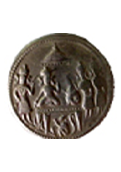The Cholas: Some Enduring Issues of Statecraft, Military Matters and International Relations
The article addresses the deficit in the indigenous, rich historical knowledge of south India. It does this by examining the military and political activities of the Cholas to understand the employment of various supplementary strategies. The article deals with the engagements and battles of the Cholas with other kingdoms of south India, and ‘externally’ with Sri Lanka. It begins with an exposition of various types of alliances that were an integral part of the military strategy of the time.
- P. K. Gautam |
- October 2013 |











